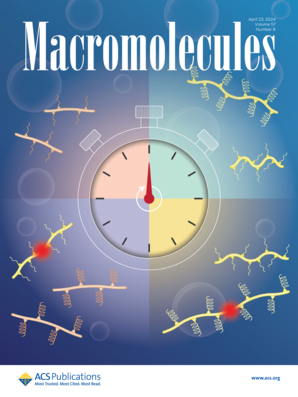Mobility and Stability Enhancements of Conjugated Polymers with Diastereomeric Conjugation Break Spacers in Organic Electrochemical Transistors
IF 5.1
1区 化学
Q1 POLYMER SCIENCE
引用次数: 0
Abstract
Organic electrochemical transistors (OECTs) offer promising advantages, such as high sensitivity, biocompatibility, and efficient ion-to-electron coupling, making them ideal for bioelectronics applications. However, challenges remain in long-term stability and doping efficiency. This study addresses these issues by incorporating conjugation break spacers (CBS) into poly(diketopyrrolopyrrole-alt-thiophene-vinylene-thiophene), introducing controlled torsion and intrinsic porosity. Among the synthesized polymers, ISB, featuring an isosorbide-based CBS with mixed endo/exoconfiguration, achieved a hole mobility of 0.839 cm2·V–1·s–1 and 74% current retention over 100 cycles, outperforming the reference P0 (0.351 cm2·V–1·s–1, 26%). Its superior OECT performance is attributed to stable molecular ordering, rapid ion transport, and reversible doping behavior. In contrast, IID, with an isoidide-based CBS, exhibited low mobility (0.0092 cm2·V–1·s–1) and poor structural order, while IMN, with an isomannide-based CBS, showed intermediate performance with limited long-term stability. This work presents a CBS-based conjugated polymer design strategy to balance mobility and stability, offering new insights into high-performance bioelectronic materials.

非对映体共轭断裂间隔剂增强有机电化学晶体管中共轭聚合物的迁移率和稳定性
有机电化学晶体管(OECTs)具有高灵敏度、生物相容性和高效的离子-电子耦合等优点,是生物电子学应用的理想选择。然而,在长期稳定性和兴奋剂效率方面仍然存在挑战。本研究通过在聚(二酮吡咯-噻吩-乙烯-噻吩)中加入偶联断裂隔离剂(CBS)来解决这些问题,引入了可控的扭转和固有孔隙度。在所合成的聚合物中,ISB具有基于异山石酯的内/外混合结构的CBS,在100次循环中实现了0.839 cm2·V-1·s-1的空穴迁移率和74%的电流保留率,优于参考P0 (0.351 cm2·V-1·s-1, 26%)。其优越的OECT性能归功于稳定的分子有序、快速的离子传输和可逆的掺杂行为。异构体基CBS的IID迁移率低(0.0092 cm2·V-1·s-1),结构有序性差;异构体基CBS的IMN迁移率中等,长期稳定性有限。这项工作提出了一种基于cbs的共轭聚合物设计策略,以平衡迁移性和稳定性,为高性能生物电子材料提供了新的见解。
本文章由计算机程序翻译,如有差异,请以英文原文为准。
求助全文
约1分钟内获得全文
求助全文
来源期刊

Macromolecules
工程技术-高分子科学
CiteScore
9.30
自引率
16.40%
发文量
942
审稿时长
2 months
期刊介绍:
Macromolecules publishes original, fundamental, and impactful research on all aspects of polymer science. Topics of interest include synthesis (e.g., controlled polymerizations, polymerization catalysis, post polymerization modification, new monomer structures and polymer architectures, and polymerization mechanisms/kinetics analysis); phase behavior, thermodynamics, dynamic, and ordering/disordering phenomena (e.g., self-assembly, gelation, crystallization, solution/melt/solid-state characteristics); structure and properties (e.g., mechanical and rheological properties, surface/interfacial characteristics, electronic and transport properties); new state of the art characterization (e.g., spectroscopy, scattering, microscopy, rheology), simulation (e.g., Monte Carlo, molecular dynamics, multi-scale/coarse-grained modeling), and theoretical methods. Renewable/sustainable polymers, polymer networks, responsive polymers, electro-, magneto- and opto-active macromolecules, inorganic polymers, charge-transporting polymers (ion-containing, semiconducting, and conducting), nanostructured polymers, and polymer composites are also of interest. Typical papers published in Macromolecules showcase important and innovative concepts, experimental methods/observations, and theoretical/computational approaches that demonstrate a fundamental advance in the understanding of polymers.
 求助内容:
求助内容: 应助结果提醒方式:
应助结果提醒方式:


